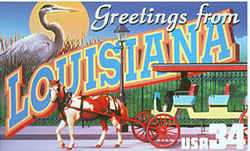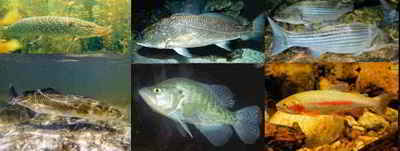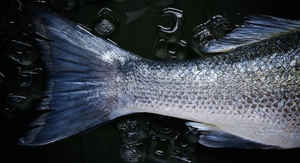
Louisiana Symbols
Louisiana State Saltwater Fish
Spotted Sea Trout or Speckled Trout

(Cynoscion nebulosus)
Adopted on May 25, 2001 .
The official state saltwater fish is the spotted sea trout, or speckled trout (Cynoscion nebulosus) so designated by Acts 2001, No. 165, §1.
Found Gulfwide from deep interior estuaries out to 30 feet of water offshore. They are a schooling species, especially when small. They are not particularly attracted to hard bottoms or structure, but tend to be found in areas of current discontinuities.
Louisiana State Saltwater Fish:
Spotted Sea Trout or Speckled Trout

The spotted seatrout, also known as speckled trout (Cynoscion nebulosus), is a common estuarine fish found in the southern United States along coasts of Gulf of Mexico and South Atlantic Ocean. While most of these fish are caught on shallow, grassy flats, spotted seatrout reside in virtually any inshore waters, from the surf of outside islands to far up coastal rivers, where they often come for shelter during cold weather. Contrary to its name, the spotted seatrout is not a member of the trout family (Salmonidae), but of the drum family (Sciaenidae). It is popular for commercial and especially recreational fishing in coastal waters of the southeastern United States. Adults reach 19-25 inches in length and 1-4 pounds in weight.
Common Names
Speckled trout are known by many different names such as spotted sea trout, specks, yellow mouths, and paper mouths
Characteristics of the Spotted Sea Trout or Speckled Trout
They are silver in color with olive-green tints on the back and numerous small black dots which extend over the dorsal fin and into the tail. The lower jaw is larger than the upper jaw which has two prominent canine teeth. In general, specks have an elongated body with a large mouth. The diet of speckled trout consists of small crustaceans, shrimp, & small fish such as pogies and croakers.
Size
Typically 1-3 pounds, fish to 5 pounds are not rare, and occasional fish exceed 10 pounds. Specks like shallow coastal areas near sandy & mud bottoms.
Habitat
That speckled trout move within an estuary on a yearly basis is well known. Typically, they spend their summers in the high-salinity areas in the lower part of an estuary and their winters in the lower salinity waters of the upper estuary. Speckled trout tend to live in or near the same bay system all their lives.
Spotted seatrout do move seasonally within a bay system, however. During the pre-spawning period of February to early April, speckled trout are scattered throughout the system. By spawning season, May to September, almost all the fish large enough to spawn are concentrated in the higher salinity waters of the lower bays. In October, with the onset of cool fronts, spotted seatrout retreat inland into lower salinity estuaries, where they typically remain well into January or February
Spawning
During spawning season, males form drumming aggregations which can number in the hundreds or even thousands of fish. Within these aggregations,
each male vibrates his air bladder, producing a croaking sound. When combined with the many other males' sounds, the result sounds like drumming or
roaring. The sound attracts females ready to spawn. Both drumming aggregations and spawning take place in areas 6-165 deep with good tidal flow, such
as passes and channels. Spawning begins at sunset and is usually over by midnight.
Speckled trout spawning activity depends on environmental factors such as currents, salinity and temperature. Most spawning activity seems to take
place in salinities of 17-35 parts per thousand (ppt). Full strength seawater is 35 ppt. The two most important factors that determine when speckled
trout spawn are water temperature and day length. Egg development begins to take place as days become longer in spring. Water temperatures of 68°F
seem to trigger spawning, which continues as water temperature increases. Peak spawning takes place between 77°F and 86°F. The cycle of the
moon also seems to affect spawning, with spawning peaks occurring on or near the full moons of the spring and summer months. Females may spawn every
7 to 14 days during the April to September spawning period.
Louisiana Law
The law designating the spotted sea trout, or speckled trout as the official Louisiana state saltwater fish is Section §170.7 (State saltwater fish) of Louisiana Statutes, Title 49 (State administration), Section RS 49:170.7.
Title 49 - State administration
SECTION RS 49:170.7.
§170.7. State saltwater fish
There shall be an official state saltwater fish. The official state saltwater fish shall be the spotted sea trout, or speckled trout (Cynoscion
nebulosus). Its use on the official documents of the state and with the insignia of the state is hereby authorized.
Acts 2001, No. 165, §1.
Taxonomic Hierarchy: Spotted Sea Trout
Kingdom: Animalia - Animal, animaux, animals
Subkingdom: Bilateria
Infrakingdom: Deuterostomia
Phylum: Chordata - cordado, chordates
Subphylum: Vertebrata - vertebrado, vertebrates
Infraphylum: Gnathostomata
Superclass: Osteichthyes - bony fishes, poissons osseux
Class: Actinopterygii - ray-finned fishes, spiny rayed fishes
Subclass: Neopterygii - neopterygians
Infraclass: Teleostei
Superorder: Acanthopterygii
Order: Perciformes - perch-like fishes
Suborder: Percoidei
Family: Sciaenidae - croakers, drums, roncadores, corbs, courbines, maigres, ombrines, corvinas y berrugatas, drums and croakers,
tambours, coakers
Genus: Cynoscion Gill, 1861 - sea trout, weak fishes, seatrouts
Species: Cynoscion nebulosus(Cuvier in Cuvier and Valenciennes, 1830) - spotted seatrout, corvina pinta







